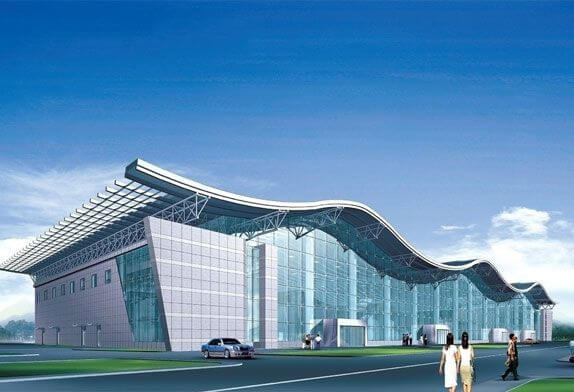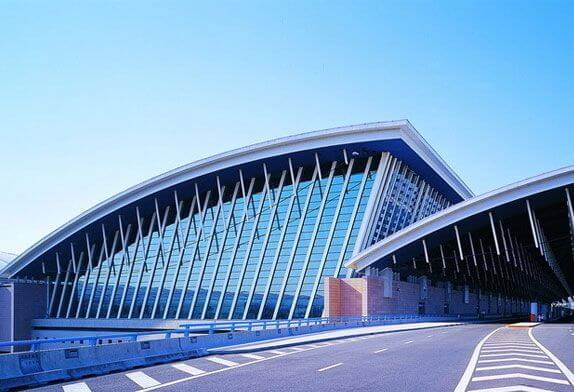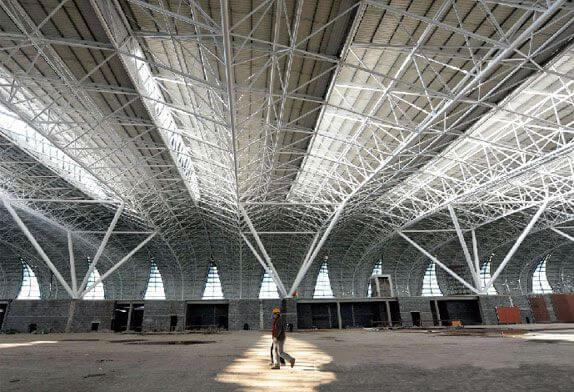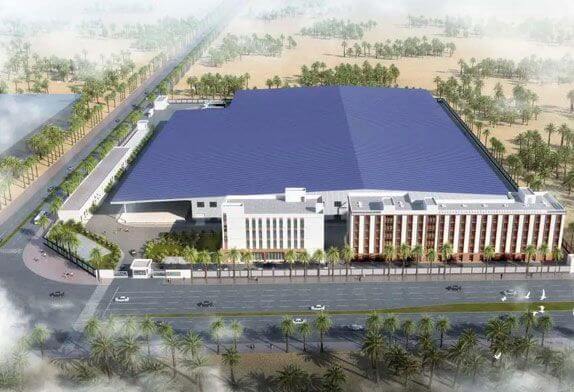+86 177 5193 6871
222, Block B, Diamond International, Guozhuang Road, Xuzhou, Jiangsu, China

The station building of the modern railway passenger station organizes ticket sales, waiting, transfer, shopping, and catering in a large public space. In order to meet the functional requirements of the station and the unique spatial form, the spatial structure system of a large span and large column network has become the first choice for station design. Commonly used structural forms are space trusses, space frames, reticulated shells, string structures, etc. “Steel has the advantages of high strength, good plasticity and toughness, lightweight, easy manufacturing, and short construction period, and is suitable for building large spans and high heights. The structure is widely used in the construction of railway passenger stations at home and abroad. However, due to the design, construction, use management, and other reasons for railway passenger station building steel structure, coupled with the influence of sunshine, high temperature, acid rain, and other external environmental factors, will affect the safety of traffic and passengers, has become the focus of railway housing construction equipment management. Therefore, strengthening the steel structure management of railway passenger station buildings is of positive significance to ensure the safety of railway transportation.

1)Unique building limit control link. Railway station building steel structure construction is an extremely complex comprehensive process, divided by main types of work, materials, construction techniques, etc., in addition to general industrial building steel structure engineering raw material acceptance, steel parts, and component processing, steel component welding, fasteners In addition to the main sub-items such as connection, steel structure installation, steel structure ancillary facilities (metal roof panels, gutters, cornice panels, decorative louvers, suspended ceilings, etc.), fire protection and anti-corrosion, there are also building boundary control links. The purpose of building boundary control is to prevent steel structures from intruding into the building boundary and ensure driving safety.、
2)Higher security requirements. Because railway buildings, especially the steel structure of the platform canopy directly affect the safety of driving and passenger boarding and landing, the safety requirements are higher than those of general industrial building steel structures. For example, poor drainage on the surface of the station house may lead to water ingress in the communication and signal rooms in the station, affecting driving safety; falling metal roof panels and platform canopy ceilings will affect driving safety.
3)The production and processing accuracy, measurement, positioning, and line-setting requirements are strict. The mechanical calculation model of steel structure is affected by the size changes of steel components, and the use and force are affected by inaccurate cutting, component deformation, and misplacement, especially in railway passenger stations where the station and bridge are integrated. The construction units of the platform canopy foundation and main steel structure generally belong to the units in front and behind the station. The engineering measurement and control are difficult and the error accumulation is significant. Small deviations of columns and other components may cause large displacement of the upper part of the steel structure, which will change the structural force, affect the design effect, and even lead to accidents.
4)The welding workload is heavy. Welding is not only a basic connection method for various steel components composed of steel plates or section steel but also a method for connecting various steel components. On-site welding occupies a large proportion of the entire steel structure project. Welding inevitably produces welding stress, welding deformation, and other welding defects, which have an impact on the quality of the steel structure.
5)The installation process is sensitive to weather, temperature, and other conditions. Steel expands with heat and contracts with cold, and the size changes greatly. Too high or too low a temperature will affect the installation accuracy. Therefore, in the connection of steel materials, the quality of welding and bolting is closely related to the weather and temperature, and it is not suitable to work in windy, rainy or snowy conditions.
6)High requirements for anti-corrosion and fire prevention. Due to the poor corrosion resistance and fireproof performance of steel, great attention must be paid to anticorrosion and fireproofing.
7)It is difficult to maintain the steel structure during the operation and management period. Due to the large volume and span of the steel structure of the railway passenger station building, high height, and many components, and the canopy roof of the existing electrified railway platform, rust removal of steel components, and anti-corrosion coating work need to be carried out during the skylight time, making maintenance difficult.

2.1 Design factors
The design factors affecting safety mainly include: the reinforcement of weak links such as the roof board should be considered in the design of the roof slab, otherwise the roof board will be easily uncovered by the wind and fall into the strand road; Whether the required operation and maintenance conditions are set, such as whether the maintenance bridleway and fall prevention facilities are set in the suspended ceiling and roof of the steel structure building; Whether to carry out overall structural health monitoring for the oversize and complex station structure, and to carry out local structural health monitoring for the important components of the station structure that are vulnerable to corrosion under harsh environment or are subject to long-term alternating load; Whether the overflow mouth is set in the gutter, otherwise it is easy for water to overflow into the station from the joint of the roof panel and the gutter.
2.2 Construction factors
(1) Invasion of building boundaries. According to the “Railway Technology Management Regulations”: All buildings (structures) and equipment must not invade the railway building boundary. If there is a building steel structure intruding into the building boundary, it will affect driving safety.
(2) Centerline offset. The deviation of the steel column and the center line of the support will change the stress mode of the steel structure, and there are potential safety hazards, such as the dislocation of the column bottom of the canopy column in the passenger passage, and the dislocation of the truss node ball at the top of the canopy column due to the deviation of the canopy foundation.
(3) Steel component blanking. The blanking of steel members must not violate the “spatial grid structure bar extension shall not be more than one time, the total number of extended bars shall not exceed 10% of the bar, and the shortest distance between the butt weld of the bar and the node or end shall not be less than 500mm” regulation.
(4) Steel structure welding. If there are defects such as missing welding, random surfacing welding, open welding, cracks, excessive deviation of the intersection of the axis of the rod, double-sided welding to single-sided welding, hinged welding to welding, and insufficient weld height, it is easy to cause the actual force of the structure to differ from that of the weld. The design does not match, resulting in node damage.
(5) Reliability of bolt connection. If the bolt is broken, the bolt or nut is missing or loose, and the size and quantity of the bolt do not meet the design requirements, the connection method shall be changed from bolt connection to welding, random addition or deletion of washers, the installation direction of high-strength nuts and washers shall be reversed, and the connection plate shall be convex after final excavation. It may cause gaps, excessive or under the protection of bolts, etc., which may easily lead to potential safety hazards.
6) Auxiliary facilities of steel structure. The factors that affect the safety of the auxiliary facilities of the steel structure of railway passenger stations are mainly as follows: whether the fixed support of the roof plate construction is short of nails, and whether the bite is in place; Treatment of connection parts, whether waterproof measures are taken to fix screws, whether the surrounding closure of gutter and water outlet is tight, otherwise it is easy to cause rain leakage of steel structure metal roof; Metal gutter rust, slope water, easy to lead to the station metal gutter due to no expansion joint thermal deformation and extrusion phenomenon; Platform canopy cornice panels, decorative louvers, suspended ceiling loose and falling.
(7) Steel structure coating conditions, mainly in: anti-corrosion and fire-proof coating conditions; whether the redundant screw holes of the bolt ball joints are blocked, otherwise it is easy to cause rust and corrosion in the ball joints, resulting in the shortened service life of the grid; on-site The anti-corrosion painting work shall not cover the center line, elevation reference point and component number of the main steel components; whether the on-site welding seams are anti-corrosion in time.
2.3 Use management factors
The important management factors affecting the safety of steel structures are whether the management unit of construction equipment performs the supervision duties in place, the professional quality of maintenance personnel, the contradiction between the shortage of technical strength of construction and maintenance, and the large increase of newly taken over construction equipment and whether the daily inspection of the steel structure of passenger station can be carried out effectively in the actual maintenance process. If welding is done at will on the steel structure after the operation takes over, or even if the load is added beyond the allowable value of the design, it will make the steel members bend and deform because of long-term overload; If the steel structure is corroded in the early stage and not effectively maintained, the corrosion will be accelerated, which will affect the safety of the steel structure of the station.

Combining the quality characteristics of the steel structure engineering of the railway passenger station, and aiming at the key links in its design, construction, and use management, the operation takeover unit can avoid bringing problems into the operation period as much as possible by strengthening early intervention, static acceptance, and use management. Ensure the safe use of steel structures in railway passenger stations.
3.1 Strengthen the steel structure of railway passenger station construction intervention in advance. The purpose of early intervention of steel structure in passenger station construction is to reduce the cost of rectification by early detection of design and construction quality problems and avoid bringing the project quality problems into the operation period. The way of early intervention: one is to attend the design review meeting, according to the relevant specifications, standards and operation and maintenance experience, find the shortcomings of the design scheme, from the source to eliminate the safety risks of housing construction equipment; The second is to supervise the key nodes that affect the construction quality of steel structure through on-site intervention in advance, especially to participate in the acceptance of concealed works that affect the quality of housing construction equipment.
3.1.1 Scheme review phase
(1) Review the design data of steel structure building limits. A comprehensive review shall be conducted, for example, the columns and cornices of housing construction equipment such as the steel structure platform canopy beside the stock road and the steel structure passenger bridge above the stock road shall be reviewed; Check the width and curve widening value; focus on checking whether the main steel structure and accessories of the canopy columns between the strands are at different heights from the rail surface.
(2) Regarding reinforcement measures for the metal roof of the station building and canopy, etc., the plan review must focus on installing windproof clamps at the joints of the metal roof panels, and installing windproof pressure strips at weak places such as the roof ridge and the end close to the gutter. . At the same time, review the plan for the use of gutter materials for the roof of the platform canopy. The gutter material should be made of stainless steel as much as possible to avoid the problem that it needs to be replaced in a short period of time due to corrosion after operation.
(3) Focus on reviewing steel structure inspection and maintenance conditions. For example: whether to set up maintenance ladders on the roof of the upper station building and platform canopy, and roof fall prevention measures; The steel structure health monitoring system is used to diagnose and warn the damage location and damage degree of the steel structure in case of extreme disasters such as strong winds, heavy snowfall, earthquakes or abnormal conditions, and provide a basis for steel structure maintenance and management decisions.
3.1.2 On-site early intervention inspection. The on-site early intervention inspection is mainly to control and supervise the key links that affect the quality of the steel structure, especially the inspection and acceptance of hidden projects.
(1) Steel column foundation inspection. The quality of the steel column foundation is directly related to the quality of the steel structure building, especially for the steel column foundation concealed by the follow-up project. Therefore, the retesting of the steel column foundation’s measurement datum point, datum line, reference elevation, control network, and recheck of the measurement results are important contents of the early intervention inspection of the steel column foundation, and the inspection results should meet the requirements of the design and relevant specifications.
(2) Inspection of roof panel support and sugar mouth fixing. In the actual construction process, there are few fixed supports for the roof panels, few nails for the supports, and few nails for the cornice panels. Therefore, it is necessary to check the fixation of the roof panel supports before installing the roof panels to implement the early intervention work of the roof panels. an important part of.
(3) Steel rods should be cut according to the maximum length as far as possible. When splicing is really necessary, it should meet the design requirements. Generally, full-penetration butt welds are used for splicing at the parts with small stress. Lined steel pipes must be installed at the splicing places. The lined pipes should be in line with the outer pipes are tightly fitted, the splicing shall not be arranged in a concentrated manner, and all butt welds shall be subject to non-destructive testing.
(4) The exposed ports of hollow steel components must use head plates and be sealed with continuous welds to isolate the internal and external air and ensure that no water accumulates in the components during assembly and installation.
(5) The design requires tight joints, the contact surface should not be less than 70% close to each other, and the maximum edge gap should not be greater than 0.8mm
(6) After the derusting treatment is qualified, the first primer should be painted within 4 hours.
(7) For ordinary bolt tension connections directly bearing dynamic loads, double nuts or other effective measures to prevent nuts from loosening should be adopted. Completion of data acceptance and on-site acceptance.
3.2.1 Key points of completion data acceptance

(1) Inspection and test reports. ①Roof wind resistance test report. The wind load design of the metal roof should be calculated according to the relevant provisions of the current national standard “Code for Building Structure Loads” (GB 50009-2012) based on the maximum wind force in the area, building height, roof slope, half of the base, building environment and building form Wind load, and provide a wind-resistance test report according to the design requirements. Third-party inspection report for internal defects of welds. ③ Sampling re-inspection report of welding consumables used in important steel structures. ④ High-strength large hexagonal head connection pair and torsional shear type high-strength bolt connection pair load moment coefficient and fastening axial force (pre-tension) factory inspection report and re-inspection report issued by the construction unit. ⑤ Anti-slip coefficient test report and re-inspection report of friction surface of high-strength bolt connection.⑥Retest report of bond strength and compressive strength performance of fire retardant coating. inspection of the material validity period. Whether the guarantee period of torque coefficient of high strength large hexagon head bolt exceeds six months. Whether the paint is past its storage expiry date.
3.2.2 Key points of on-site acceptance In addition to checking the rectification of problems found in advance and common problems in steel structures, the static acceptance work also needs to check the following key contents.
(1) Check the verticality and plane curvature of the steel column. The measurement of the verticality of the steel column should be selected in the time when the sunlight and temperature difference have little influence, such as morning, evening and cloudy measurements, and the inspection results should meet the specifications and design requirements.
(2) Steel grid deflection inspection. The deflection value of the steel grid structure should be measured after the completion of the assembly and the completion of the roofing project, and the measured deflection value should not exceed 1.15 times the corresponding design value. For steel grid structures with a span of 24 m or less, measure the central point of the lower chord; for steel grid structures with a span of 24 m or more, measure the central point of the lower chord and the quarter points of each lower chord span.
(3) Key points of visual inspection. In the grid structure, the nodes play the role of connecting the converging rods and transmitting internal force, and are also the connection points between the grid and the roof structure, ceiling, pipeline equipment, etc. The center of gravity axis intersection of the truss structure rods is not allowed to deviate more than 3.0 mm
(4) Inspection of weld defects. Check for common weld defects such as cracks, porosity, slag inclusion, incomplete penetration, root shrinkage, full weld, weld penetration, undercut, butt misalignment, welding deformation, etc.
(5) Bolt connection inspection. Check whether the bolts are loose or under-tightened after all the bolts are tightened; whether the bolt connection meets the requirements of the construction quality acceptance specification after the final tightening; whether the surface contact of the bolted joints is smooth and free of gaps.
(6) Inspection of operation and maintenance conditions. After the painting is completed, whether the signs, marks and numbers of the components are clear, complete and complete; whether the weight, center of gravity position and positioning marks of major components are marked.
(7) Clean up construction residues. There may be construction residues such as welding rods, iron parts, nylon ropes, and water bottles on the roof, steel structure suspenders, and suspended ceilings. These objects pose potential safety hazards for driving and must be cleaned up during static acceptance.
(8) Anti-corrosion coating inspection. Check the adhesion of anti-corrosion coatings; for the parts that are prohibited from painting, they must be shielded and protected before construction. If the friction surface of high-strength bolts is painted, it will directly cause the anti-slip coefficient of the friction surface to decrease and affect the safety of the structure; It is the inspection of the coating thickness and paint quality of the stress-bearing nodes; the bolt ball joints and the space grid structure connected by high-strength bolts, after the installation is completed, the gaps and redundant screw holes of the tie rod sleeves should be filled with oil putty and sealed. Carry out anti-corrosion treatment according to regulations.
(9) Key points of metal roof inspection. Whether there are overflow holes in the gutter and eaves; whether the expansion joints of the metal gutter and eaves meet the requirements of the specification; the length of the metal plate extending into the gutter and eaves; , Whether the overlapping width of the metal ridge cover plate on the metal on the two slopes meets the requirements of the specification. In addition, metal roof expansion joint covers, fascias, and other parts are checked for potential safety hazards such as looseness, cracking, deformation, and falling off that affect driving and passenger landing.
